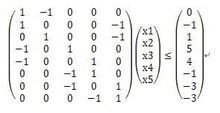POJ 3159 Candies差分约束系统 spfa 附:各种最短路比较
Description
During the kindergarten days, flymouse was the monitor of his class. Occasionally the head-teacher brought the kids of flymouse’s class a large bag of candies and had flymouse distribute them. All the kids loved candies very much and often compared the numbers of candies they got with others. A kid A could had the idea that though it might be the case that another kid B was better than him in some aspect and therefore had a reason for deserving more candies than he did, he should never get a certain number of candies fewer than B did no matter how many candies he actually got, otherwise he would feel dissatisfied and go to the head-teacher to complain about flymouse’s biased distribution.
snoopy shared class with flymouse at that time. flymouse always compared the number of his candies with that of snoopy’s. He wanted to make the difference between the numbers as large as possible while keeping every kid satisfied. Now he had just got another bag of candies from the head-teacher, what was the largest difference he could make out of it?
Input
The input contains a single test cases. The test cases starts with a line with two integers N and M not exceeding 30 000 and 150 000 respectively. N is the number of kids in the class and the kids were numbered 1 through N. snoopy and flymouse were always numbered 1 and N. Then follow M lines each holding three integers A, B and c in order, meaning that kid A believed that kid B should never get over c candies more than he did.
Output
Output one line with only the largest difference desired. The difference is guaranteed to be finite.
Sample Input
2 2 1 2 5 2 1 4
Sample Output
5
Hint
看到这种谁比谁多的情况就应该想到差分约束系统!
啥是差分约束系统??
代码:
#include <iostream>
#include <cstdio>
#include <cstring>
using namespace std;
const int maxn=30005;
int dis[maxn],head[maxn];
int n,m,sum;
bool vis[maxn];
struct node{
int v,w,next;
}edge[150010];
void addedge(int a,int b,int c){
edge[sum].v=b;
edge[sum].w=c;
edge[sum].next=head[a];
head[a]=sum++;
}
bool spfa(int s){
int stack[maxn],outque[maxn],top=0;
memset(dis,0x3f,sizeof(dis));
memset(vis,0,sizeof(vis));
memset(outque,0,sizeof(outque));
stack[top++]=s;
vis[s]=1;//vis数组的作用不是判断它是否被更新过 而是是否在栈里!
dis[s]=0;
while(top){
int tmp=stack[--top];
vis[tmp]=0;
outque[tmp]++;
if(outque[tmp]>n) return 0; //判断负环,当然这里没有必要写它
int k=head[tmp];
while(k>-1){
if(dis[edge[k].v]>edge[k].w+dis[tmp]){
dis[edge[k].v]=edge[k].w+dis[tmp];
if(vis[edge[k].v]==0){
vis[edge[k].v]=1;
stack[top++]=edge[k].v;
}
}
k=edge[k].next;
}
}
return 1;
}
int main()
{
//freopen("cin.txt","r",stdin);
while(cin>>n>>m){
sum=0;
memset(head,-1,sizeof(head));
int a,b,c;
while(m--){
scanf("%d%d%d",&a,&b,&c);
addedge(a,b,c);
}
spfa(1);
printf("%d\n",dis[n]);
}
return 0;
}
另:
Dijkstra:适用于权值为非负的图的单源最短路径,用斐波那契堆的复杂度O(E+VlgV)
